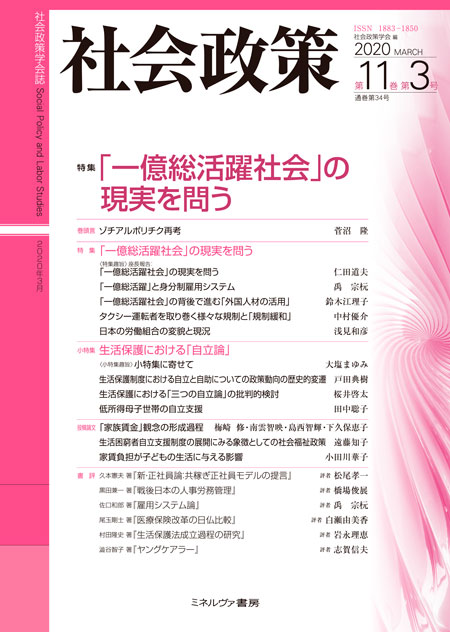Volume 11, Issue 3
Displaying 1-23 of 23 articles from this issue
- |<
- <
- 1
- >
- >|
Foreword
-
2020Volume 11Issue 3 Pages 1-5
Published: March 20, 2020
Released on J-STAGE: April 04, 2022
Download PDF (634K)
Special Issue :Examining the Reality of the Plan to Build a Society in Which All 100 Million People Play an Active Role
-
2020Volume 11Issue 3 Pages 7-13
Published: March 20, 2020
Released on J-STAGE: April 04, 2022
Download PDF (753K) -
2020Volume 11Issue 3 Pages 14-28
Published: March 20, 2020
Released on J-STAGE: April 04, 2022
Download PDF (895K) -
2020Volume 11Issue 3 Pages 29-41
Published: March 20, 2020
Released on J-STAGE: April 04, 2022
Download PDF (1129K) -
2020Volume 11Issue 3 Pages 42-56
Published: March 20, 2020
Released on J-STAGE: April 04, 2022
Download PDF (950K) -
2020Volume 11Issue 3 Pages 57-72
Published: March 20, 2020
Released on J-STAGE: April 04, 2022
Download PDF (1069K)
Special Report : The Argument for Promoting Independence in Public Assistance
-
2020Volume 11Issue 3 Pages 73-76
Published: March 20, 2020
Released on J-STAGE: April 04, 2022
Download PDF (681K) -
2020Volume 11Issue 3 Pages 77-90
Published: March 20, 2020
Released on J-STAGE: April 04, 2022
Download PDF (938K) -
2020Volume 11Issue 3 Pages 91-101
Published: March 20, 2020
Released on J-STAGE: April 04, 2022
Download PDF (865K) -
2020Volume 11Issue 3 Pages 102-112
Published: March 20, 2020
Released on J-STAGE: April 04, 2022
Download PDF (777K)
Article
-
2020Volume 11Issue 3 Pages 113-125
Published: March 20, 2020
Released on J-STAGE: April 04, 2022
Download PDF (926K) -
2020Volume 11Issue 3 Pages 126-138
Published: March 20, 2020
Released on J-STAGE: April 04, 2022
Download PDF (829K) -
2020Volume 11Issue 3 Pages 139-150
Published: March 20, 2020
Released on J-STAGE: April 04, 2022
Download PDF (792K)
Book Reviews
-
2020Volume 11Issue 3 Pages 151-154
Published: March 20, 2020
Released on J-STAGE: April 04, 2022
Download PDF (898K) -
2020Volume 11Issue 3 Pages 154-158
Published: March 20, 2020
Released on J-STAGE: April 04, 2022
Download PDF (900K) -
2020Volume 11Issue 3 Pages 158-162
Published: March 20, 2020
Released on J-STAGE: April 04, 2022
Download PDF (947K) -
2020Volume 11Issue 3 Pages 162-165
Published: March 20, 2020
Released on J-STAGE: April 04, 2022
Download PDF (893K) -
2020Volume 11Issue 3 Pages 165-169
Published: March 20, 2020
Released on J-STAGE: April 04, 2022
Download PDF (899K) -
2020Volume 11Issue 3 Pages 169-173
Published: March 20, 2020
Released on J-STAGE: April 04, 2022
Download PDF (897K)
-
2020Volume 11Issue 3 Pages 174-179
Published: March 20, 2020
Released on J-STAGE: April 04, 2022
Download PDF (438K) -
2020Volume 11Issue 3 Pages 180-182
Published: March 20, 2020
Released on J-STAGE: April 04, 2022
Download PDF (597K) -
2020Volume 11Issue 3 Pages 184-185
Published: March 20, 2020
Released on J-STAGE: April 04, 2022
Download PDF (568K) -
2020Volume 11Issue 3 Pages Cover2-
Published: March 20, 2020
Released on J-STAGE: April 04, 2022
Download PDF (6834K)
- |<
- <
- 1
- >
- >|
